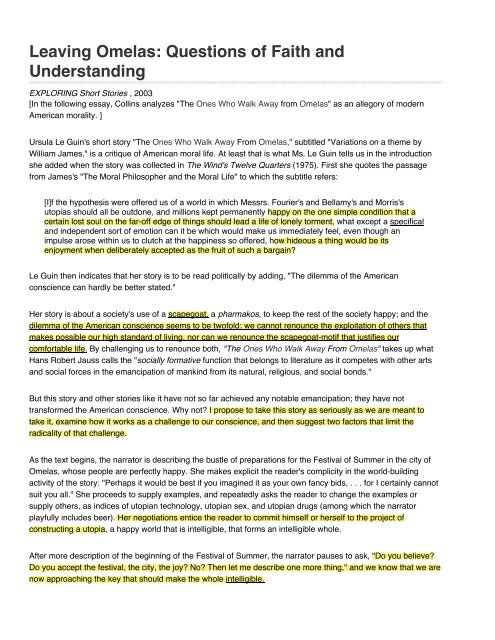
In the streets between houses with red roofs and painted walls, processions moved. Because the child has experienced no part of the utopian world the citizens of Omelas have come to know, it doesn’t have to experience the realization that a world once thought perfect is painfully flawed. The Festival of Summer came to the city of Omelas, bright-towered by the sea. Those are the terms.” (Ursula Le Guin, 6) Before this passage in the text, a thorough description of the child is provided, the main point being that it has lived neglected for its entire life. If the child were brought up into the sunlight out of that vile place, if it were cleaned and fed and comforted, that would be a good thing, indeed but if it were done, in that day and hour all the prosperity and beauty and delight of Omelas would wither and be destroyed. They would like to do something for the child. Our lives depend on the poor people because for the wealthier people they need that poor person to be above. you with high-quality and low-cost custom essays, research The Ones Who Walk Away From Omelas Symbolism Essay papers, term papers, speeches, book reports, and other academic assignments for sale. Omelas resembles our society because the adolescent children and grown ups are the poor or homeless, and some tend to care for demand some walk away. They feel anger, outrage, impotence, despite all the explanations. The Ones Who Walk Away From Omelas Symbolism Essay. They feel disgust, which they had thought themselves superior to. The story is an allegory about a utopian.

It is the existence of the child, and their knowledge of its existence, that makes possible the nobility of their architecture, the poignancy of their music, the profundity of their science." (Ursula Le Guin, 7) This section of the text is referring to the knowledge that the citizens of Omelas receive at …show more content… According to the text, “No matter how well the matter has been explained to them, these young spectators are always shocked and sickened at the sight. Le Guin’s short story The Ones Who Walk Away from Omelas, which was first published in 1973, then. They know that they, like the child, are not free.

Theirs is no vapid, irresponsible happiness. According to the text, "Yet it is their tears and anger, the trying of their generosity and the acceptance of their helplessness, which are perhaps the true source of the splendor of their lives. This represents the judgmental side of people that is always present, even in a perfect society. A theme that can be discovered in The Ones Who Walk Away From Omelas is knowledge can be equally or more painful than pain itself. The ones who walk away from Omelas are the people who refuse to take part in the unjust community, they represent those in society who are unwilling to comply to norms if they find them immoral.


 0 kommentar(er)
0 kommentar(er)
